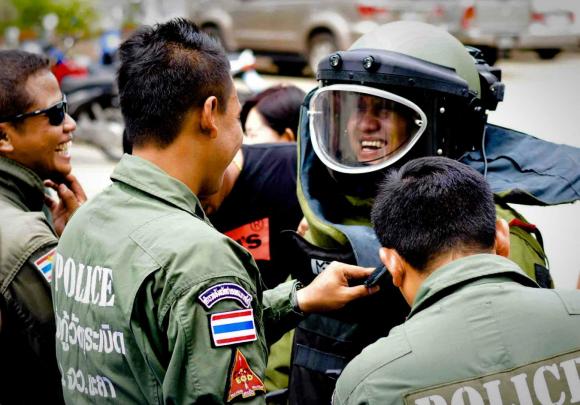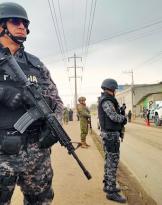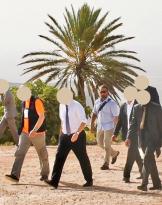Ravens Challenge appears to be the largest C-IED and EOD exercise, including its training activity. With the new geopolitical setups and new challenges in Southeast Asia, many of the Asian nations are looking to upgrade their EOD / IED skills. We had the pleasure of interviewing Ravens Challenge Director Al Johnson, former EOD Commander of the US Army and currently consultant to the Royal Thai Police, Unit 191 (EOD).
Mr Al Johnson, would like to briefly analyze for us the local, regional and strategic criticalities in Thailand, a nation which, together with all of Asia, is becoming an increasingly crucial geopolitical and military area. The Thai king Bhumibol Adulyadej passed away on 13 October, does he already have his own personal idea of the political and military future of the nation?
Thailand has long been a region of great importance in Southeast Asia. In the last century it had a role of "buffer zone" for the French and the British Empire, and in most of the second half of the twentieth century, that of buffer between communist and democratic governments. Located in the Southeast Asian region, it acts as a central node and guarantor of global stability. As a “land of passage” Thailand could also cause potential instability that could be exploited by various political and terrorist groups. Already in Indonesia and Malaysia, for example, Da'esh (euphemistically ISIS) has established its presence. These more violent radical groups threaten to hook up with local rebels in southern Thailand and could escalate the violence so it can expand beyond the traditional borders of Yala, Narathiwat and Patthani. Thailand must maintain a stable government and security presence during the transition period and thereafter ensure that the transition is not exploited by Da'esh and similar groups, in order to conduct independent operations or to link with existing insurgent groups. Further complications would arise if the "Chinese expansionism" factor pushed Thailand to become a "more aligned" country, in the near future, in Beijing. Recent joint activities by Thai government factions indicate that China is looking carefully at this transition period as a potential time to be exploited to its advantage. However, these challenges mean Thailand continues to accelerate its modernization programs.
Mr Johnson, what is the "RAVENS challenge" in the military and in the civil world?
It has always been essential for us to organize practical, realistic and accurate, large-scale, and multi-jurisdictional training, in order to provide commanders, government officials, and public safety personnel with the ability to effectively address a local, national and regional level IED devices and other threats related to the danger of explosives. Ravens Challenge would thus allow units to develop the skills necessary to face current and future threats from IED devices, and to work with police, military and even private forces, while maintaining public safety and security.
Where is the Ravens training held annually?
The larger-scale training takes place in Thailand every year and is co-hosted by the Royal Thai Police. We also host local and national trainings in the United States where the need arises. These teams with their commanders can participate, even in the international one, thus developing a network of work and cooperation, aimed at countering the threat of IED devices.
What is the user of the Ravens Challenge exercises? Are the teams national or international?
Both; national and international. To these are added the EOD K-9, SWAT, Intelligence, Forensics, and medical support teams to combat threats from explosives, chemical threats, etc. Each scenario provided requires an EOD team in order to integrate and use the support departments.
Mr. Johnson, do you think the Maritime IED (C-IED) response is about to face new challenges for the future?
Absolutely. LTTE rebels in Sri Lanka have shown that a small uprising, equipped with maritime IED devices could inflict damage and casualties on a large scale, which no one thought was possible in the absence, for example, of a major and national military force that could afford to finance. the heel. It was 10 years ago. The technology and knowledge base is now expanded and with drone technology it is improved; rebel groups can use IEDs and disrupt both maritime trade and sovereignty. Depending on the region and intensity, an attack with maritime IEDs can have a greater impact than a riot of land-based IEDs. For example, the Ravens Challenge this year began training EOD teams based on a potential threat and "providing assistance and expertise" to the development of new response protocols, as well as intelligence gathering and exploitation frameworks, for this maritime threat.
What is your opinion on the future scenarios C-IED, IED and EOD? I mean technically speaking.
It is always fascinating to ask "what will happen". We have already seen the use of IED-launching drone technology in Syria. Bombs, "kamikaze" drones, remote control car bombs, first attempts at chemical devices. The effective possibility for rebel and terrorist groups to use IED devices increases every day thanks to the internet, new ideas are even shared, groups become more and more effective. This is why military and public security must always be accompanied, not only by training for the ongoing threat, but also by monitoring what would be tested around the world, countering it below. I personally see IED drones as a new wave of attacks, as drones get cheaper and the ability to carry loads increases.
(photo: Ravens Challenge)












